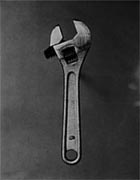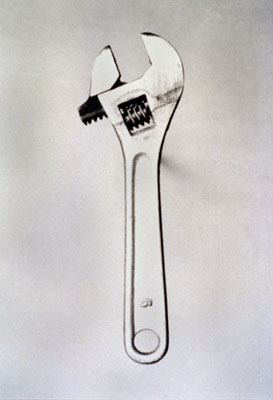
that gif is the walker evans 1955 "the beauty of common tools" series taken from this site.

notes :
Among low-priced, factory-produced goods, none is so appealing to the senses as the ordinary hand tool. . . . Aside from their functions—though they are exclusively wedded to function—each of these tools lures the eye to follow its curves and angles, and invites the hand to test its balance.
Walker Evans's introduction to "Beauties of the Common Tool," an article that appeared in the July 1955 issue of Fortune magazine, makes clear his appreciation for the most ordinary apparatus. Photographing pliers, chisels, trowels, scissors, and bevels was a fitting assignment for Evans, who found items of everyday use intriguing. Using plain surfaces and extended exposures so that his large-format negatives would capture every nuance of texture, Evans transformed mundane tools like this crescent wrench into works of sculpture.
Admiring the "fine naked impression of the heft and bite in the crescent wrench," Walker Evans wrote in the 1955 portfolio, Beauties of the Common Tool: "Among the low-priced, factory-produced goods, none is so appealing to the sense as the ordinary hand tool. Hence, the hardware store is a kind of offbeat museum show for the man who responds to good, clear 'undesigned' forms."
Walker Evans wrote in the 1955 portfolio, Beauties of the Common Tool: "Among the low-priced, factory-produced goods, none is so appealing to the sense as the ordinary hand tool. Hence, the hardware store is a kind of offbeat museum show for the man who responds to good, clear 'undesigned' forms."
For Fortune magazine in 1955, Evans shot black-and-white closeups of tools. Pliers, a trowel, a wrench, a crate opener--these aren't normally the stuff of aesthetic admiration. Evans shows that they can be. Light and shadow play across the cool, smooth metal, and the curved shapes of handles, and strong angle of a blade become pure form and design. The viewer can feel what it is like to hold each implement in the hand, to put it to the task. In a brief commentary accompanying the pictures, Evans wrote that these basic, common tools stand for "elegance, candor, and purity.'' Much the same could be said for Evans.
Walker Evans's introduction to "Beauties of the Common Tool," an article that appeared in the July 1955 issue of Fortune magazine, makes clear his appreciation for the most ordinary apparatus. Photographing pliers, chisels, trowels, scissors, and bevels was a fitting assignment for Evans, who found items of everyday use intriguing. Using plain surfaces and extended exposures so that his large-format negatives would capture every nuance of texture, Evans transformed mundane tools like this crescent wrench into works of sculpture.
bibliography
In a 1954 letter to his boss Hedley Donavan at Fortune magazine Walker Evans used the following lanuage to "sell" a certain portfolio idea.
THE BEAUTIES OF THE COMMON TOOL. A dozen or so large, sensuous black-and-white picture studies of hand tools bought in ordinary hardwarw stores. Sensuous is the word. Extremely careful though simple studio photographs. The photographer will assume that a certain monkey-wrench is a museum piece. The camera will drool over this and a countersink and a plumb blob. Abstract volupte. All will be strictly pure design: that is to say, no chiqued-up.
Raymond Lowey or Dreyfus commercial corruptions will be allowed it this show.
In penciled notes he went further.
Time and again a man will stand before a hardware store window eying the tools arrayed behind the glass; his mouth will water; he will go in and hand over $2.65 for a perfectly beautiful special kind of polished wrench; and probably he will never, never use it for anything.
Finally, In an accompanying text for the 1955 Fortune magazine photo spread he waxed even further.
...fine naked impression of the heft and bite in the crescent wrench...
...these basic, common tools stand for elegance, candor, and purity.
Among the low-priced, factory-produced goods, none is so appealing to the sense as the ordinary hand tool. Hence, the hardware store is a kind of offbeat museum show for the man who responds to good, clear 'undesigned' forms.
Aside from their functions—though they are exclusively wedded to function—each of these tools lures the eye to follow its curves and angles, and invites the hand to test its balance.
|
- bill 10-21-2004 11:06 pm
that gif is the walker evans 1955 "the beauty of common tools" series taken from this site.
- bill 10-21-2004 11:16 pm [add a comment]
- bill 10-22-2004 2:53 am [add a comment]
notes :
Among low-priced, factory-produced goods, none is so appealing to the senses as the ordinary hand tool. . . . Aside from their functions—though they are exclusively wedded to function—each of these tools lures the eye to follow its curves and angles, and invites the hand to test its balance.
Walker Evans's introduction to "Beauties of the Common Tool," an article that appeared in the July 1955 issue of Fortune magazine, makes clear his appreciation for the most ordinary apparatus. Photographing pliers, chisels, trowels, scissors, and bevels was a fitting assignment for Evans, who found items of everyday use intriguing. Using plain surfaces and extended exposures so that his large-format negatives would capture every nuance of texture, Evans transformed mundane tools like this crescent wrench into works of sculpture.
Admiring the "fine naked impression of the heft and bite in the crescent wrench," Walker Evans wrote in the 1955 portfolio, Beauties of the Common Tool: "Among the low-priced, factory-produced goods, none is so appealing to the sense as the ordinary hand tool. Hence, the hardware store is a kind of offbeat museum show for the man who responds to good, clear 'undesigned' forms."
Walker Evans wrote in the 1955 portfolio, Beauties of the Common Tool: "Among the low-priced, factory-produced goods, none is so appealing to the sense as the ordinary hand tool. Hence, the hardware store is a kind of offbeat museum show for the man who responds to good, clear 'undesigned' forms."
For Fortune magazine in 1955, Evans shot black-and-white closeups of tools. Pliers, a trowel, a wrench, a crate opener--these aren't normally the stuff of aesthetic admiration. Evans shows that they can be. Light and shadow play across the cool, smooth metal, and the curved shapes of handles, and strong angle of a blade become pure form and design. The viewer can feel what it is like to hold each implement in the hand, to put it to the task. In a brief commentary accompanying the pictures, Evans wrote that these basic, common tools stand for "elegance, candor, and purity.'' Much the same could be said for Evans.
Walker Evans's introduction to "Beauties of the Common Tool," an article that appeared in the July 1955 issue of Fortune magazine, makes clear his appreciation for the most ordinary apparatus. Photographing pliers, chisels, trowels, scissors, and bevels was a fitting assignment for Evans, who found items of everyday use intriguing. Using plain surfaces and extended exposures so that his large-format negatives would capture every nuance of texture, Evans transformed mundane tools like this crescent wrench into works of sculpture.
- bill 10-22-2004 2:55 am [add a comment]
bibliography
- bill 10-26-2004 9:03 pm [add a comment]
In a 1954 letter to his boss Hedley Donavan at Fortune magazine Walker Evans used the following lanuage to "sell" a certain portfolio idea.
In penciled notes he went further.
Finally, In an accompanying text for the 1955 Fortune magazine photo spread he waxed even further.
- bill 10-28-2004 5:47 pm [add a comment]